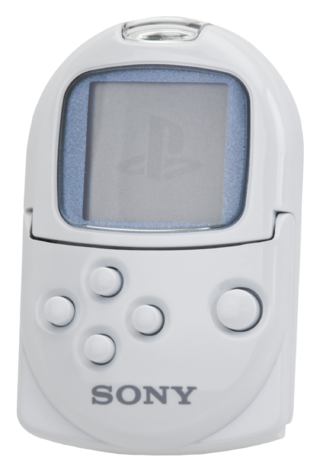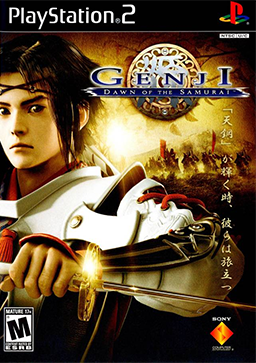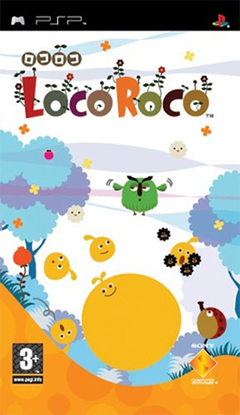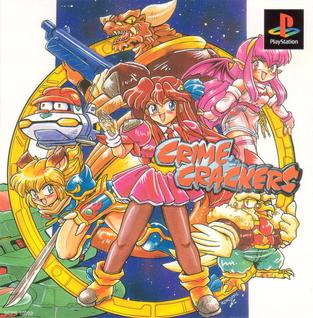
The PlayStation is a home video game console developed and marketed by Sony Computer Entertainment. It was released in Japan on 3 December 1994, in North America on 9 September 1995, in Europe on 29 September 1995, and in Australia on 15 November 1995. As a fifth-generation console, the PlayStation primarily competed with the Nintendo 64 and the Sega Saturn.

A sampler is an electronic musical instrument that records and plays back samples. Samples may comprise elements such as rhythm, melody, speech, sound effects or longer portions of music.

The EyeToy is a color webcam for use with the PlayStation 2. Supported games use computer vision and gesture recognition to process images taken by the EyeToy. This allows players to interact with the games using motion, color detection, and also sound, through its built-in microphone. It was released in 2003 and in total, it has 6 million sales .

Amplitude is a 2003 rhythm game developed by Harmonix and published by Sony Computer Entertainment for the PlayStation 2. It is the sequel to Frequency (2001). The game was released in 2003 for North America on March 25 and for Europe on September 26.

I.Q: Intelligent Qube, also known as Intelligent Qube in North America and Kurushi in Europe, is a 1997 puzzle video game developed by G-Artists and published by Sony Computer Entertainment for the PlayStation. In the game, the player controls a character who must run around a platform made of cubes, clearing certain cubes as they approach. Cubes are "cleared" by marking a spot on the stage, waiting for the cube to roll on top of it, and then deactivating the marked spot.

Dark Chronicle, released as Dark Cloud 2 in North America, is a 2002 action role-playing game developed by Level-5 and published by Sony Computer Entertainment for the PlayStation 2 (PS2). It was released in Japan before releasing in English in 2003. An emulated version of the game was released for the PlayStation 4 through the PlayStation Network in 2016.

Ultima Underworld: The Stygian Abyss is a first-person role-playing video game developed by Blue Sky Productions and published by Origin Systems. Released in March 1992, the game is set in the fantasy world of the Ultima series. It takes place inside the Great Stygian Abyss: a large cave system that contains the remnants of a failed utopian civilization. The player assumes the role of the Avatar—the Ultima series's protagonist—and attempts to find and rescue a baron's kidnapped daughter.

EyeToy: Groove is a dancing game developed by London Studio and published by Sony Computer Entertainment. It was released on November 14, 2003 in Europe, on April 20, 2004 in North America, and on June 24, 2004 in Japan as EyeToy: FuriFuri Dance Tengoku. In EyeToy: Groove the player must hit targets with their arms on the edges of the screen to the beat of the music.

The PocketStation is a memory card peripheral by Sony Interactive Entertainment for the PlayStation home video game console. It was released in Japan in 1999. The device acted not only as a memory card, but was interactive itself via a small monochrome LCD display and buttons on its case. Many PlayStation games included software that could be downloaded and played on the PocketStation. A release in Europe and North America was planned, but was ultimately canceled. The PocketStation shares similarities with Sega's VMU for the Dreamcast.

Rage Racer is the third title in the Ridge Racer series of racing games on the PlayStation following Ridge Racer Revolution (1995), and fifth overall title in the series. Developed and published by Namco, it was released in Japan on December 3, 1996, with releases elsewhere following in 1997. It was the first game in the series to feature a CGI animated introduction, and introduced a new "mascot", Reiko Nagase.

Tomba! 2: The Evil Swine Return, or simply Tomba! 2, is a platform-adventure game developed by Whoopee Camp and published by Sony Computer Entertainment for the PlayStation. The game was released in Japan in 1999 and in other territories the following year. The game is a sequel to Tomba! and centers on the exploits of the eponymous feral child as he attempts to rescue his friend Tabby from an evil race of anthropomorphic pigs.

Genji, released as Genji: Dawn of the Samurai in North America, is a 2005 action-adventure video game developed by Game Republic and published by Sony Computer Entertainment for the PlayStation 2. It is loosely based on The Tale of the Heike. A sequel, Genji: Days of the Blade, was released for the PlayStation 3.

Armored Core 3 is a 2002 third-person shooter mecha video game developed by FromSoftware for the PlayStation 2. It is the sixth entry in the Armored Core series. Armored Core 3 acts as a reboot for the franchise and begins a storyline that would continue through Armored Core: Last Raven. In 2009, Armored Core 3 was ported to the PlayStation Portable.

LocoRoco is a platform video game developed by Japan Studio and published by Sony Computer Entertainment, which was released worldwide in 2006 for the PlayStation Portable (PSP) handheld game console. The game was developed by Tsutomu Kouno, striving to create a game that was different from other titles being released for the PSP at the time. After demonstrating a prototype of the core gameplay to his management, Kouno was able to complete development over the course of a year and a half. In LocoRoco, the player must tilt the environment by using the shoulder buttons on the PSP in order to maneuver the LocoRoco, multi-colored jelly-like characters, through each level, being aided by other odd residents while avoiding hazards and the deadly Moja Troop, to reach an end goal.

White Knight Chronicles is a fantasy role-playing video game developed by Level-5 and Japan Studio and published by Sony Computer Entertainment for the PlayStation 3. It is Level-5's first project for the system. As of August 2009 it has sold 350,000 copies in Japan. A sequel titled White Knight Chronicles II was released in Japan in 2010. A related game for the PlayStation Portable, titled White Knight Chronicles: Origins was released in Japan, Europe and, Australia in 2011.

LittleBigPlanet is a 2008 platform game developed by Media Molecule and published by Sony Computer Entertainment for the PlayStation 3, and is the first game of the LittleBigPlanet franchise. The level editor is the main focus of the game, allowing the player to create levels and publish them online. The player controls Sackboy, a customizable ragged doll with the ability to create. Story mode consists of pre-made levels built around Sackboy's basic control scheme, and they are grouped into areas, each centering around a theme; the story revolves Sackboy helping various Creator Curators around LittleBigPlanet before facing the Collector, who has been kidnapping and stealing creations.

Rapid Racer, known as Turbo Prop Racing in North America, is a racing video game developed by SCE Studios Soho and published by Sony Computer Entertainment exclusively for the PlayStation. In the game, the player takes control of a motorboat and races around six different tracks. Eventually, all six tracks can be raced mirrored, as well as set at night time.

A synthesizer is an electronic musical instrument that generates audio signals. Synthesizers typically create sounds by generating waveforms through methods including subtractive synthesis, additive synthesis and frequency modulation synthesis. These sounds may be altered by components such as filters, which cut or boost frequencies; envelopes, which control articulation, or how notes begin and end; and low-frequency oscillators, which modulate parameters such as pitch, volume, or filter characteristics affecting timbre. Synthesizers are typically played with keyboards or controlled by sequencers, software or other instruments, and may be synchronized to other equipment via MIDI.

Kileak: The DNA Imperative, known as Kileak: The Blood in Japan and Europe, is a first-person shooter video game developed by Genki for the PlayStation. It was published in Japan by Sony Music Entertainment in January 1995, followed by a North American and European release in September 1995 by Sony Computer Entertainment as a launch game for the console. Kimitaka Matsumae, former member of the S.S.T. Band, wrote the game's soundtrack.

Crime Crackers is a first-person shooter/action role-playing video game developed by Media.Vision and published by Sony Computer Entertainment for the PlayStation. Based on a science fiction manga set after an intergalactic war, the story follows of group of bounty hunters aboard the spacecraft Pink Dolphin as they take on jobs requested by the Galactic Federation police. Gameplay resembles dungeon crawlers, largely consisting of exploring complex 3D corridors, collecting items, and shooting enemies. The player is able to freely rotate between three unique characters within missions, while points earned afterwards can be used to purchase consumable items and upgraded equipment.




















